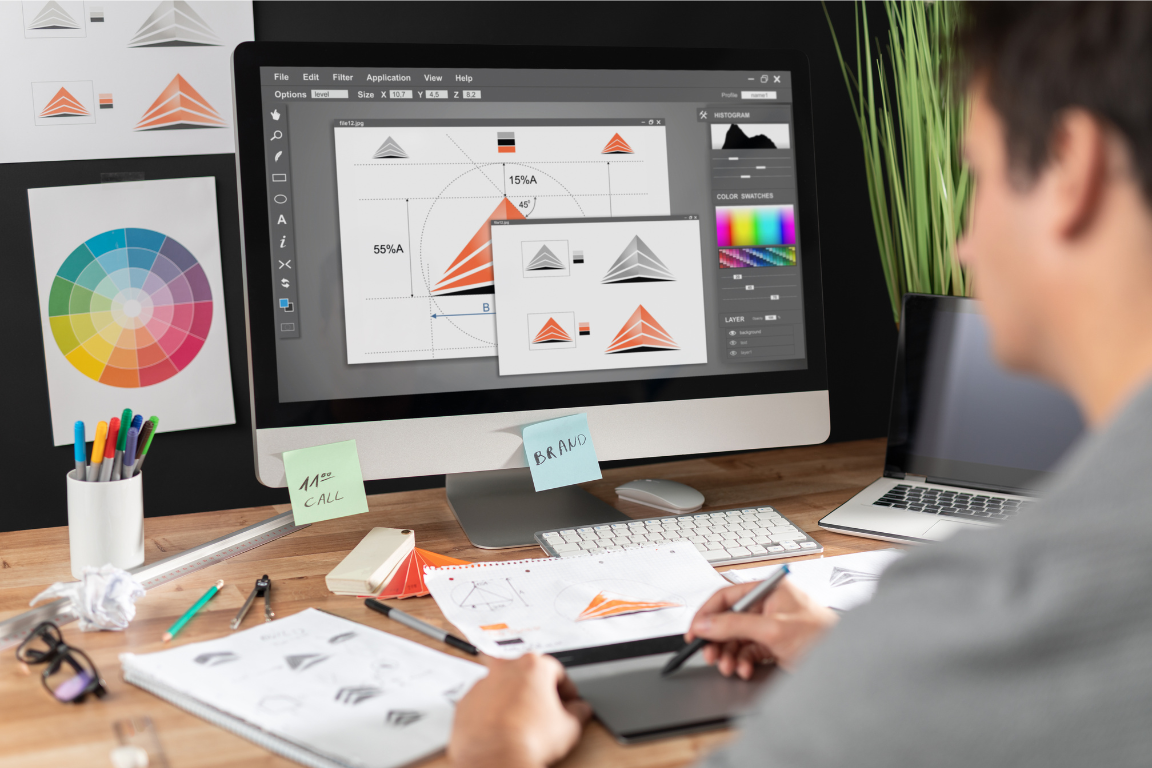
The Graphic Design Course is structured to delve into both fundamental and advanced aspects of graphic design, offering a comprehensive exploration of major and minor subjects within the field. Graphic design, as a form of visual communication, evolves dynamically, employing a vast array of technical processes to engage audiences. Through this course, you’ll be introduced to diverse working methods, practices, and techniques inherent in graphic design.
This course covers a wide spectrum of graphic design, from foundational concepts to practical application, providing students with a well-rounded understanding and skill set in the field of graphic design.
Instructor : Muhammad Usman
Graphic design is a form of visual communication that is a diverse and constantly reformulating practice that uses a wide range of technical processes to engage with audiences. The graphic design course introduces you to a range of working methods, practices and techniques.
1- Identify the purpose, audience, and audience needs for preparing images.
2- Determine whether content is relevant to the purpose, audience, and audience needs.
3- Understanding key differences of Creativity vs Innovation, the Creative/Design Process and Flow
4- Demonstrate knowledge of basic project management concepts.
1- Demonstrate knowledge of techniques for communicating about design plans with peers and clients.
2- Demonstrate knowledge of key terminology related to digital images.
3- Demonstrate knowledge of digital image terminology.
4- Demonstrate knowledge of how colour is created in digital images.
5- Demonstrate knowledge of basic design principles and best practices employed in the design industry.
6- Communicate visually using the elements and principles of design and common design techniques.
1- Identify and use common typographic adjustments to create contrast, hierarchy, and enhanced readability/legibility.
2- Demonstrate knowledge of common font hierarchical composition terms and principles by conserving a precious and scarce commodity: audience attention.
3- Add and manipulate text using appropriate typographic settings.
4- Adjust character settings in a design.
5- Transcending words to art by converting text to graphics.
1- Modify the appearance of design elements by using filters and styles.
2- Use filters to modify images destructively or non-destructively.
3- Apply, modify, copy, and remove layer styles.
4- Create, manage, and save custom layer styles.
5- Use core tools and features to create visual elements.
6- Create images using a variety of tools.
7- Modify and edit vector images using a variety of vector tools.
1- Evaluate or adjust the appearance of objects, or selections, using various tools.
2- Apply photographic changes to images using tools and adjustments.
3- Explore Prints and posters.
4- Explore Visual Identity and Logo Design.
5- Transform digital graphics and media.
6- Modify the canvas or art boards.
7- Rotate, flip, and modify individual layers, objects, selections, or graphical elements.
8- Apply basic auto-correction methods and tools.
9- Use various tools to repair and reconstruct images.
1- Use layers to manage design elements.
2- Use the layers panel to modify layers.
3- Manage layers in a complex project.
4- Work with multiple layers.
5- Flatten and merge layers.
6- Modify layer visibility using opacity, blending modes, and masks.
7- Adjust a layer’s opacity, blending mode, and fill opacity.
1- Create a document with the appropriate settings for web, print, and video.
2- Apply and use of Photomontage, Assemblage and Digital collage/e-Collage
3- Create a new document pre-set to reuse for specific project needs.
4- Destructive and Non-destructive editing: Smart Objects, Smart Filters, and adjustment layers.
5- Destructive editing: painting, adjustments, erasing, and rasterizing.
6- Navigate, organize, and customize the application workspace.
7- Identify and manipulate elements of the Photoshop interface.
1- Manage colours and gradients.
2- Set the active center and background colour.
3- Create and customize gradients.
4- Create and edit swatches.
5- Manage brushes, symbols, patterns and format styles.
6- Open and peruse libraries of included brushes, symbols, graphic styles, and patterns.
1- Identify the purpose, audience, and audience needs for preparing images.
2- Determine whether content is relevant to the purpose, audience, and audience needs.
3- Understanding key differences of Creativity vs Innovation, the Creative/Design Process and Flow
4- Demonstrate knowledge of basic project management concepts.
1- Introduction to Fiverr
2- Creating an Effective Fiverr Profile
3- Understanding Fiverr Gigs
4- Managing Client Communication and Orders
5- Promoting and Growing on Fiverr
1- Introduction to Upwork
2- Creating an Upwork Profile
3- Bidding and Proposals on Upwork
4- Managing Projects on Upwork
5- Scaling Your Upwork Presence
1- Introduction to Real-time Projects
2- Assigning Commercial Projects
3- Guidance and Mentorship
4- Presentation and Delivery
5- Reflection and Learning
1- Confirmed Opportunities
2- Professional Development
3- Mentorship Continuation
4- Networking Opportunities
5- Resume Enrichment
6- Performance Recognition
Copyright 2023 © SkillsCo | Powered by SkillsCo Team